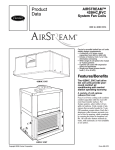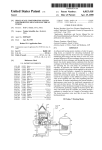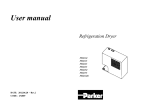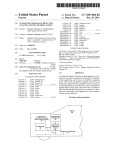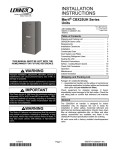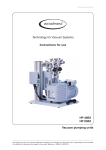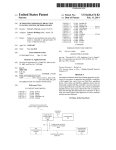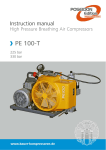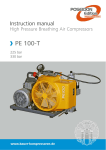Download Carrier AIRSTREAM 42BVC Specifications
Transcript
AIRSTREAM™ 42BHC,BVC06-40 System Fan Coil Air Conditioners Installation, Start-Up and Service Instructions SAFETY CONSIDERATIONS Air-handling equipment is designed to provide safe and reliable service when operated within design specifications. To avoid injury to personnel and damage to property or equipment, use good judgement and follow safe practices as outlined below when installing and operating this equipment. diagram installed on the blower housing or specific manufacturer literature for any other type of factory-mounted controls. See drawings for unit configurations, dimensions, clearances, and pipe connections. Refer to unit wiring label for all electrical connections. Follow NEC (National Electrical Code) and local codes. INSTALLATION NEVER REACH INTO a unit while the fan is running. LOCK OPEN AND TAG the fan motor power disconnect switch before working on unit. In addition, remove the fuses and take them with you after noting this on tag. Failure to do so may result in electrical shock or personal injury. ALL POWER MUST BE DISCONNECTED before any installation or service should be attempted. More than one power source may be supplied to a unit. Power to remote mounted control devices may not be supplied through the unit. CHECK THE WEIGHT of assembly and components to be sure that rigging equipment can handle them safely. NEVER PRESSURIZE a coil with a non-liquid for leak testing. A dangerous burst may occur. DO NOT STEAM CLEAN coils until you are sure all personnel are clear of the area. INTRODUCTION This document contains general installation instructions for the 42BHC,BVC fan coil units. Refer to the unit-wiring Step 1 — Unpack and Inspect Unit — Remove shipping wraps from unit and check shipment against shipping list. Check for concealed shipping damage. If shipment is damaged or incomplete, file claim with transportation company and advise Carrier immediately. Step 2 — Protect Unit From Damage — To maintain warranty, protect unit against adverse weather conditions, theft or vandalism on the jobsite. The equipment covered in this manual IS NOT suitable for outdoor installations. The equipment should never be stored or installed where it may be subjected to a hostile environment such as rain, snow, or extreme temperatures. Step 3 — Prepare Jobsite for Unit Installation — To save time and to reduce the possibility of costly errors, set up a complete sample installation in a typical room at jobsite. Check all critical dimensions such as pipe, wire and duct connection requirements. Refer to job drawings and product dimension drawings as required. Instruct all trades in their part of the installation. For unit component identification, refer to Fig. 1. For unit dimensions, refer to Fig. 2 for 42BHC units and Fig. 3 for 42BVC units. Fig. 1 — Component Identification (42BHC Units Shown) Manufacturer reserves the right to discontinue, or change at any time, specifications or designs without notice and without incurring obligations. Catalog No. 534-236 Printed in U.S.A. Form 42B-1SI Pg 1 2-07 Replaces: 42BH-5SI Book 3 Tab 7a UNIT 42BHC Fan Size Depth Width Height 06 08 10 12 16 20 30 40 9x 4 9x 6 10 x 4 10 x 7 11 x 10 12 x 9 12 x 12 15 x 12 363/16 363/16 373/4 373/4 3715/16 403/8 403/8 439/16 2811/16 2811/16 371/16 371/16 471/16 481/16 481/16 621/16 181/2 181/2 201/4 201/4 201/4 223/4 31 31 A 7 1 /8 89/16 7 1 /2 915/16 135/16 121/2 157/8 167/16 DIMENSIONS (in.) Supply Duct B C 109/16 137/8 109/16 137/8 1111/16 137/8 1111/16 137/8 11 12 /16 1613/16 133/4 173/4 133/4 161/16 161/16 2213/16 D 1 1 /8 1 1 /8 1 1 /8 1 1 /8 1 1 /8 1 1 /8 6 1 /8 5 1 /8 Return Duct E F 241/16 167/16 241/16 167/16 331/16 183/16 331/16 183/16 1 43 /16 183/16 441/16 2011/16 441/16 2815/16 581/16 2815/16 Mounting Holes J K 273/16 351/4 273/16 351/4 363/16 3613/16 363/16 3613/16 3 46 /16 37 473/16 397/16 473/16 397/16 613/16 425/8 NOTES: 1. All dimensions are in inches (±1/4 in.). 2. Any modifications to product specifications by any person are subject to acceptance of the factory. Product specifications are subject to change without notice. 3. Right hand shown, left hand opposite. 4. Hanger rods, which are field-supplied, are shown for reference only. Fig. 2 — Unit Dimensions — 42BHC Units through. Be sure to support the unit from underneath until mounting is complete. 2. Install vibration isolators as shown in Fig. 1. Field furnished and installed accessories must be independently supported or suspended. It is recommended that a trapeze suspension be used on 42BHC30 and 40 units. Step 4 — Identify and Prepare Units — Be sure that unit power requirements match available power source. Refer to unit nameplate and wiring diagram. Check all tags on unit to determine if any shipping screws are to be removed. Remove screws as directed. Step 5 — Place Unit In Position 1. The air handler has 5/8-in. knockouts in each corner of the top and bottom panels for suspension rods to pass 2 DIMENSIONS (in.) UNIT 42BVC Fan Size Depth Width Height 06 08 10 12 16 20 30 40 9x 4 9x 6 10 x 4 10 x 7 11 x 10 12 x 9 12 x 12 15 x 12 20 20 22 22 22 24 28 28 281/16 281/16 371/16 371/16 471/16 481/16 481/16 621/16 361/2 361/2 393/8 393/8 393/8 451/8 543/16 575/8 A 7 1 /8 89/16 7 1 /2 915/16 135/16 121/2 157/8 167/16 Supply Duct B 109/16 109/16 1111/16 1111/16 1211/16 133/4 133/4 161/16 C 3 3 /4 3 3 /4 5 1 /2 5 1 /2 167/8 1713/16 161/8 227/8 Return Duct E F 241/16 167/16 241/16 167/16 1 33 /16 183/16 331/16 183/16 431/16 183/16 441/16 2011/16 1 44 /16 2815/16 581/16 2815/16 NOTES: 1. All dimensions are in inches (±1/4 in.). 2. Any modifications to product specifications by any person are subject to acceptance of the factory. Product specifications are subject to change without notice. 3. Right hand shown, left hand opposite. 4. Hanger rods are field-supplied. Fig. 3 — Unit Dimensions — 42BVC Units 3 factor for any change in operating conditions. The A dimension must equal the system TSP plus 1-in. wg. The B dimension is one half of A, and C is the total of A + B + pipe diameter. The unit drain pan is equipped with a secondary connection that must be piped to an open-site drain. This will prevent overflow and possible building damage if the primary drain is blocked. The secondary drain connection can be capped if potential overflow will not damage the building or unit. WATER SUPPLY/RETURN CONNECTIONS — Install piping in accordance with all applicable codes. The supply and return connections are marked on the coil stub ends with an “S” on the supply (inlet) and an “R” on the return (outlet). Blue letters mark chilled water connections, red letters indicate steam or hot water connections. Install valves in lines in accordance with valve manufacturer’s instructions. Be sure valves are in proper operating position and are easily accessible for adjustment. HYDROSTATIC TEST — When all joints are completed, perform hydrostatic test for leaks. Hydronic systems should be tested with water (some components are not designed to hold gas). If gas testing is necessary, pressure must NOT exceed 80 psi. All chilled water piping and valves not located over drain pans or drip lips must be insulated to prevent damage from sweating. Vent all coils at this time. (See Step 9, section 6.) 3. For units with mixing boxes, a base rail must be used. Mixing boxes are preassembled from the factory for ease of installation. A linkage kit consisting of two crank arms, 2 swivels, and either a 25-in. (sizes 06-16) or a 34-in. (sizes 20-40) length of 5/16-in. rod is provided for field installation of actuator. Assemble base rails provided with mixing box. All hardware is included and base rails are letter coded for ease of assembly. Place unit on base rails. Install mixing box and attach to base rail using the no. 8 x 1/ -in. fasteners. Seal the connection between mixing box 2 and return duct flange. Be careful not to tape or seal the filter access panel. 4. To ensure proper drainage and operation, be sure unit is level. DO NOT mount the unit on a slope. The pitch of a suspended unit can change after coil is filled; recheck after filling. Drain pan has built-in slope to ensure proper drainage. 5. Sufficient clearance must be maintained for service and maintenance. Ensure that there is a minimum clearance of 24-in. on access side for motor, pulley and belt access. If side access to filter is desired, the minimum clearance required is the width of the filter rack plus 6 inches. 6. Protect unit from damage from jobsite debris. Do not allow foreign material to fall into drain pan. Prevent dust and debris from being deposited on motor or fan. Step 6 — Make Piping Connections (See Table 1 and Fig. 2 and 3) Never pressurize unit beyond the specified test pressure. Always pressure test with an inert gas or fluid (nitrogen or clear water) to avoid possible unit damage or personal injury in the event of a leak during testing. DRAIN — The unit has a double-sloped condensate drain pan to ensure proper drainage. The condensate drain must be at least 3/4-in. copper, galvanized, black iron, or PVC piping. Install the trapped drain line in accordance with all applicable codes. Slope drain away from unit to prevent overflowing and insulate the line to prevent sweating. Drain piping should be sloped a minimum of 1/8-in. per ft away from the unit. Condensate drain must be trapped for proper drainage and odor control. The differential height of the trap inlet to outlet must be at least 1-in. wg greater than the total static pressure of the unit. The differential height of the outlet to the bottom of the trap must not be less than the total static pressure of the unit. The 42BVC units should be installed on a pad. The height of the pad should be adequate to allow for a proper condensate trap. The condensate trap shown in Fig. 4 is for a unit with a total static pressure (TSP) of 2-in. wg with a 1-in. wg safety Check interior unit piping for signs of leakage from shipping damage or mishandling. If leaks are found, notify a Carrier representative before initiating any repairs. All water coils must be protected from freezing after initial filling with water. Even if system is drained, unit coils may still hold enough water to cause damage when exposed to temperatures below freezing. INSULATION — Following the hydrostatic test, insulate all piping to unit to prevent sweating. Table 1 — Unit Physical Data UNIT SIZE 42BHC, BVC NOMINAL CFM 42BHC SHIPPING WT (lb) (no heat/ with heat) 42BVC SHIPPING WT (lb) (no heat/ with heat) FILTERS (2 in. pleated) Quantity...Size (in.) Face Area (sq ft) COILS Size (in.) Face Area (sq ft) Fins per inch Coil Water Weight (approx. lb per row of coil) FANS Quantity...Size (in.) 06 600 08 800 10 1000 12 1200 16 1600 20 2000 30 3000 40 4000 203/234 205/236 253/287 256/290 312/346 344/380 437/474 553/590 200/231 202/233 243/277 247/281 289/323 351/387 436/473 522/559 1...161/2 x 24 2.8 1...161/2 x 24 2.8 1...181/4 x 33 4.2 1...181/4 x 33 4.2 2...181/4 x 211/2 5.5 2...203/4 x 22 6.3 2...29 x 22 8.9 2...29 x 29 11.7 15 x 20 2.1 15 x 20 2.1 15 x 29 3.0 15 x 29 3.0 15 x 39 4.1 18 x 40 4.9 27 x 40 7.7 27 x 54 10.3 0.240 0.240 0.324 0.324 0.420 0.492 0.768 1.020 1...9 x 4 1...9 x 6 1...10 x 4 1...10 x 7 1...11 x 10 1...12 x 9 1...12 x 12 1...15 x 12 10 COPPER COIL CONNECTION 8 ROW (in.) (Cooling) COPPER COIL CONNECTION 4 AND 6 ROW (in.) (Cooling) 11/2 OD 1 OD 3/ 4 OD COPPER COIL CONNECTION 1 AND 2 ROW (in.) (Heating) 1 OD 1/ 3/ DRAIN CONN. SIZES (in.) 4 2 4 OD MPT 11/2 OD 2. Clean unit thoroughly. Remove dirt and debris from unit, especially drain pan, drain line, motor and fan. Pour water into drain pan to check that drain operates properly. 3. Rotate fan wheel by hand to be sure it is free and does not rub housing. The 42BHC and 42BVC belt drives are factory set at the speed required for the design specifications specified when ordered. These drives may be adjusted to achieve different speed by qualified personnel during air system balancing. Refer to the Start-Up section before energizing the unit. Check fan belt tension as described in the Service section which follows. 4. Check that a clean air filter of proper type and size is installed in unit filter rack after commissioning. See Table 1 and Service section entitled To Clean or Replace Air Filters. Do not operate unit without filter. 5. Turn on water supply. Open all valves. Check for leaks. Recheck pitch of suspended unit. 6. Vent all air from unit coil and related piping. If air vent is manual, release air by turning air vent screw 11/2 turns counterclockwise with screwdriver. When a steady stream of water begins to escape, close valve. If vent is automatic, trapped air will be released automatically. Vent releases air slowly, usually dripping water into the drain pan in the process. 42BHC/BVC UNIT CASING 3.0 A 1.5 B C ALLOW A MINIMUM OF “C” INCHES FROM BOTTOM OF UNIT TO FINISHED FLOOR (42BVC UNIT) OR TO FALSE CEILING (42BHC UNIT). CLEAN-OUT NOTE: Dimension C is the total of A + B + the pipe diameter. Fig. 4 — Condensate Trap Step 7 — Make Electrical Connections — Refer to the unit rating plate for supply voltage, motor and heater amperage, and required circuit ampacities. The unit wiring diagram, shows all factory and field wiring. Most of the unit motors are dual voltage that are factory wired for a specified voltage. The motors should be checked to ensure that they are wired for the correct voltage and rotation. Units equipped with factory-installed motor controls and disconnect will comply with NEC requirements for disconnect, motor controller and motor overload protection. Separate disconnect and motor starter are not required to comply with NEC requirements. All field wiring should be done in accordance with all applicable local and national codes. Any factory wiring modifications without factory authorization will void all factory warranties and nullify any agency listings. The manufacturer assumes no responsibility for any damage and/or injuries resulting from improperly installed or wired components. Install fan switches, thermostats and other accessories in accordance with accessory manufacturer’s instructions and applicable wiring diagram. Step 8 — Make Duct Connections — Install all ductwork to and from unit in accordance with all applicable codes. Duct construction must allow unit to operate within the limits of the unit external static pressure as shown on job submittals. Units designed to operate with ductwork may be damaged if operated without the intended ductwork attached. Units configured to bring in outside air should have some method of low temperature protection to prevent coil freeze-up. Insulate all ductwork as required. Use flexible connections to minimize duct-to-duct alignment problems and noise transmission where specified. Acoustic lining of main supply and return duct should be considered for noise control. Noise transmission will be reduced when return grilles are located as far as possible from the unit. Install ductwork, accessory grilles, and plenums so that they do not restrict access to filter. Prevent dirt, dust, and debris from settling in unit. The air vent provided on the unit is not intended to replace the main system vents and may not release air trapped in other parts of the system. Inspect the entire system for potential air traps and vent those areas as needed. Some systems may require repeated venting over a period of time to properly eliminate air from the system. 7. POWER ON (Close unit electrical disconnect.) NOTE: Be sure power is off before making any adjustments inside unit. 8. Check fan and motor operation. Motor to fan wheel rotation must match airflow direction shown in Fig. 2 and 3. Set unit air delivery for required blower rpm per Job Submittals or Product Data catalog. Adjust fan motor pulley (Fig. 5) as follows: a. Loosen setscrew on movable pulley flange. b. Screw flange towards fixed flange to increase fan speed and away from fixed flange to decrease speed. c. Reset setscrew. d. Check belt tension.The drive belt should be tensioned to allow 1/2 to 3/4-in. deflection at the midpoint between pulleys with moderate pressure. Inspect the unit for loose wires, correct blower wheel operation, and loose or missing access panels or doors. Unless otherwise required for balancing and start-up procedures, units should not be operated without proper ductwork; supply/return air grilles, and access panels and/or doors in place. Step 9 — Make Final Preparations Do not exceed motor nameplate FLA (Full Load Amps). Operator must confirm motor current draw before putting unit into service and again after air balancing the system. 1. POWER OFF (Open unit electrical disconnect.) 5 To Clean Coil 1. Brush between coil fins with a stiff wire brush. Do not bend fins. Follow up by cleaning with a vacuum cleaner. If coil is cleaned with an air hose, take care not to drive dirt and dust into other components. 2. Install clean air filters. To Check Drain — Check drain pan, drain line and trap at start of each cooling season. A standard type pipe cleaner for 3/ -in. ID pipe can ensure removal of obstructions so that con4 densate is carried away. Check the drain line at filter cleaning time during the cooling season. Fan and Motor Bearings — Fan shaft bearings are permanently lubricated and sealed, and need no attention. Check tag on motor for motor bearing lubrication instructions (if any). Most motors furnished with these units are permanently lubricated. To Align Pulley — Loosen pulley setscrew(s). Align pul- Fig. 5 — Fan Pulley Adjustments START-UP leys by using a straight edge as shown in Fig. 5. Retighten setscrew(s). Follow all safety considerations outlined at the beginning of this manual. To Adjust Fan Belt Tension — Loosen fan motor base mounting screws. Reposition the motor so that belt deflection does not exceed 3/16-in. at belt midpoint under 8-lb. of force. Retighten motor mounting screws and recheck fan belt tension. Start-up procedures vary depending upon the time of year (summer or winter) and building characteristics (new building or old building, occupied or unoccupied, etc.). Start-up in the Cooling mode requires that proper care be given to avoid condensation problems. Condensation forms on surfaces that are colder than the dew point of the surrounding air. If a unit is started and is fed low-temperature chilled water in a hot, humid setting, condensation will form on many parts of the unit. In order to avoid excessive condensation, water of higher temperature should be used — approximately 65 to 70 F. Also, the building should be as completely enclosed as possible and outside air supply fans and toilet and kitchen exhaust fans should be off. As the building temperature drops, the chilled water temperature can gradually be reduced until it reaches 50 F. At this point, the outside air fans can be turned on. When the chilled water temperature is reduced to its design point the exhaust fans can be turned on. To Clean Fan Wheel — Use a stiff brush or vacuum to remove dirt and debris from scroll. Wipe all fan surfaces with a damp cloth. To Clean or Replace Air Filters — At the start of each cooling season and after each month of operation (more or less depending on operating conditions), replace unit filter. To remove filter, slide filter out of filter rack from either side of return air duct collar. THROWAWAY OR PLEATED FILTER — Replace filter with a good quality filter of the size shown in Table 1. Do not attempt to clean and reuse a disposable filter. Excessive Condensation on Fan Coil Unit Parts — Excessive condensation can be caused by running chilled water through a fan coil unit with its fan off. Therefore, if fan cycling control is used, a water flow control valve should be installed to shut off the water when the fan stops. The following two practices will also help avoid condensation problems: 1. Continuous fan operation, with motorized chilled water valve controlled by thermostat. 2. Continuous fan operation, with thermostat control to switch fan from high to low speed (instead of switching it off). Air System Balancing — All ductwork, air grilles, fil- ters, access doors and panels must be complete and connected to establish actual system operating conditions before air system balancing procedures are started. NOTE: Units are factory set for system designed operating conditions specified at the time of order entry. Proper belt drive alignment and tension must be maintained when adjusting the unit fan drive speed. The drive belt tension should not exceed 3/16-in. deflection midway between the pulleys under 8-lb. of force. New belts tend to stretch during their initial period of use. After 5 days of operation, check and readjust belt tension and pulley alignment if necessary. Failure to do so may result in excessive unit noise and/or premature belt/ bearing failure. Motor Overload — The following are causes and remedies for motor trip-out on overload: 1. Cause: Fan delivers too much air because external static pressure is lower than the design pressure. Remedy: Reduce fan speed by adjusting motor pulley or changing fan shaft pulley to larger diameter. 2. Cause: Air temperature across fan motor is too high (heating mode). Remedy: Check ambient temperature on motor’s nameplate. Compare to actual air temperature at the motor or at the fan discharge. If motor’s nameplate lists an ambient temperature of 40 C (104 F) and the actual air temperature is higher, either lower the air temperature or obtain a special motor rated for high ambient temperatures. SERVICE Avoid possible injury or death. Lock open and tag electrical disconnect before servicing equipment. 6 Copyright 2007 Carrier Corporation Manufacturer reserves the right to discontinue, or change at any time, specifications or designs without notice and without incurring obligations. Catalog No. 534-236 Printed in U.S.A. Form 42B-1SI Pg 8 2-07 Replaces: 42BH-5SI Book 3 Tab 7a








